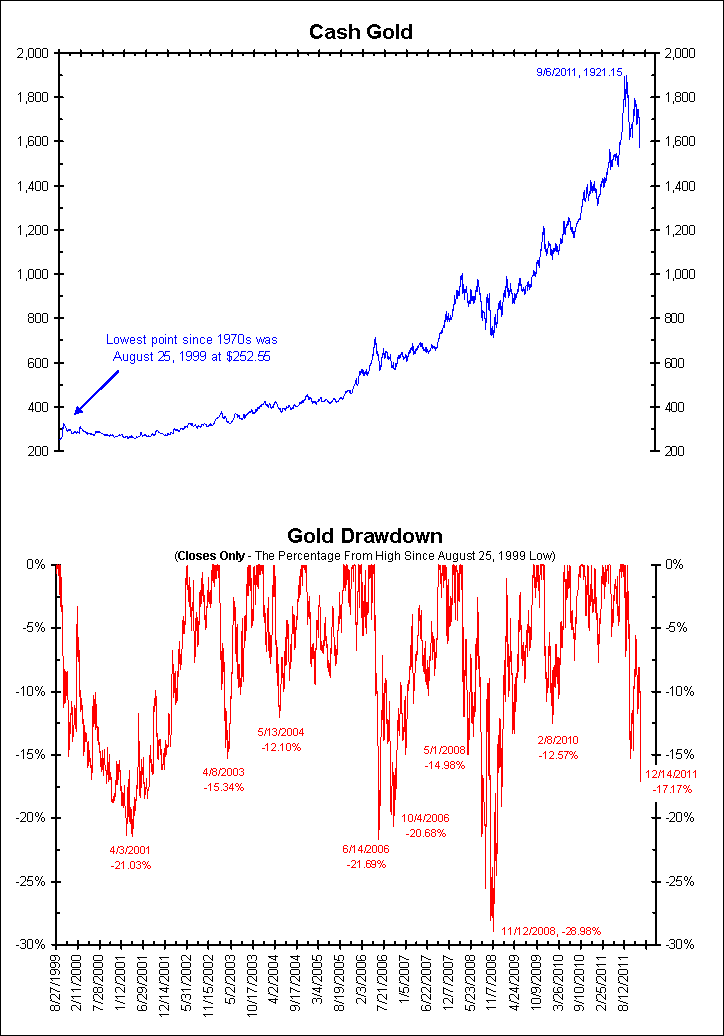MarketWatch – Gold quits 200-day average, first since 2009
Gold’s recent selloff pushed the precious metal through its 200-day moving average for the first time since Jan. 2009 early Wednesday. That’s usually a bad sign for an asset, as these moving averages are used to even out daily blips and signal a shift in a long-term trend…Bespoke Investment Group notes:
If it closes below $1,612.80 on Wednesday the commodity will end what has been the longest streak of consecutive closes above its 200-day moving average since at least 1975. After rallying nearly 125% since the start of the current streak to its highs earlier in the year, gold has now declined by 16% and is up 88% since the current streak began.
MarketBeat (WSJ Blog) – Will Gold’s Pain Be the Stock Market’s Gain?
The current selloff in gold prices looks like the real thing, and the safe-haven metal’s technical behavior relative to stocks suggests the breakdown could eventually prove to be a boon for Wall Street. The SPDR Gold Shares Trust exchange traded fund slid below the 200-day simple moving average on Tuesday, which many view as a dividing line between long-term uptrends and downtrends, for the first time since January 2009. That by itself suggests this decline is different than the other pullbacks of more than 10% that have occurred since then. But if that’s not enough, those previous pullbacks–starting in February 2009, December 2009 and September 2011–followed periods of sharp increases in short interest in the GLD. This time, GLD short interest as of Nov. 30 settlement dropped 31% in two weeks to a nine-month low. And Tom McClellan, publisher of the McClellan Market Report, also noted that one-month borrowing rates for gold have increased to the highest spread over one-month LIBOR in the 22-year history of gold lease rate data. This means it has become as expensive as ever to borrow gold to short it, meaning there isn’t much left in the market except long positions. When bulls look around and see nothing but other bulls, they tend to get antsy enough to leave the party.
The Financial Times – Gold’s stellar status brought to earth
When it comes to investment safety, gold has near-mythical status. Sadly, it has repeatedly turned out to be a myth that gold holds its value during periods of panic… Gold is meant to be a haven, and in periods of mild fear it does rather well. This is not mild fear. The euro tumbled below $1.30 for the first time since January, as Italian bond yields rose further and traders realised last week’s treaty was far from a done deal. But just as in 2008, when times get really tough, investors prefer cash to gold – and dollar cash at that. Goldbugs like to treat gold as a currency, and its price as an exchange rate. On that basis, gold fell against the dollar, as investors decided the greenback is safer in times of crisis.
Zero Hedge (Blog) – About Gold And The 200 DMA
Many are doing their damnedest Ph.D.-best to somehow fuse economic theory and technical charting, and state that a breach of the 200 DMA in gold is indicative of imminent price collapse. And then there are facts. Such as this nugget from Stone McCarthy which looks at previous episodes of the 200 DMA breach and concludes based on severity of trendline penetration compared to average, that “this is just one reason we see strong potential for a rebound as participants reduce short exposure.” So much for technicals. Full note from SMRA:
For the first time since January 2009, gold closed below its 200-day moving average on Wednesday. Today’s Chart of the Day puts Wednesday’s -2.8% violation of this long-term smoothing line into perspective, by comparing it to the average violation of both the general and upward sloping 200-day average since 1999.
The slope of a moving average is something that many analysts fail to address when trying to determine potential turning points on a chart. Although gold has been working lower for more than 3 months now, the current upward slope of the 200-day line reinforces the fact that gold’s long-term trend is still to the upside.
If we simply consider the general direction of the 200-day moving average since the start of the yellow metal’s secular bull move in late 1999, gold’s average distance below this line is -3.70%, with a maximum undercut of -19.2%. On the other hand, if we only consider gold’s performance when the slope of the 200-day line is higher, the average violation is -2.19%, with a maximum undercut of -10.8%.
Source: Arbor Research


